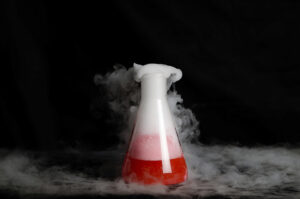The Wonders of Dry Ice: Home Science Experiments

Using dry ice in home science experiments can be educational and a lot of fun!
Dry ice, the solid form of carbon dioxide (CO₂), is a mesmerizing material that captures the imagination with its foggy, vapor-producing properties. Unlike regular ice, dry ice sublimates directly from a solid to a gas at -78.5°C (-109.3°F), bypassing the liquid phase. This unique characteristic makes it a fantastic tool for a variety of captivating and educational home science experiments. If you do decide to do home science experiments with dry ice, please remember to follow proper safety practices, especially if you’re doing these with young children.
The Classic Dry Ice Fog Effect
One of the simplest yet most dramatic experiments with dry ice is creating fog. This occurs when dry ice sublimates and the cold CO₂ gas cools the surrounding water vapor, forming a dense fog. To perform this experiment:
Materials Needed: Dry ice, warm water, a large bowl or container.
Procedure
- Fill the container with warm water.
- Using tongs or insulated gloves, carefully add a few chunks of dry ice to the water.
- Observe the billowing fog that forms almost immediately.
This experiment vividly demonstrates the sublimation process and the gas’s interaction with warm water, making it an excellent visual aid for teaching about states of matter and gas behavior.
Dry Ice Bubbles
Creating dry ice bubbles is a fun and visually appealing experiment that illustrates the concept of gas expansion and surface tension.
Materials Needed: Dry ice, warm water, a large bowl, liquid dish soap, and a piece of cloth or rag.
Procedure
- Fill the bowl with warm water and add a few chunks of dry ice to generate fog.
- Dip the cloth or rag into a mixture of water and dish soap, then run it along the rim of the bowl to create a film.
- As the dry ice sublimates, the CO₂ gas will fill the bowl and push against the soap film, forming a bubble dome over the bowl.
This experiment highlights the properties of gases and surface tension in liquids, creating a fascinating, hands-on learning experience.
Dry Ice and Balloon Inflation
This experiment showcases the expansion of gas and the pressure it can exert on its surroundings.
Materials Needed: Dry ice, balloons, warm water, a bottle or container with a narrow neck.
Procedure
- Place a few small pieces of dry ice into the bottle.
- Quickly stretch the balloon’s mouth over the bottle opening.
- As the dry ice sublimates, the CO₂ gas will inflate the balloon.
Watching the balloon inflate demonstrates the expansion of gases and provides an engaging way to discuss gas laws and the behavior of molecules at different temperatures.
The Screaming Metal Experiment
This experiment produces a high-pitched sound that helps explain the rapid sublimation and thermal conductivity of dry ice.
Materials Needed: Dry ice, metal spoon.
Procedure
- Press the metal spoon against a chunk of dry ice.
- Listen to the “screaming” or high-pitched noise that results from the rapid sublimation of dry ice as it comes into contact with the warm metal.
This auditory experiment helps illustrate thermal conductivity and the intense cold of dry ice, providing a multi-sensory approach to learning.
Safety Overview
While dry ice is a fantastic tool for conducting home science experiments, it requires careful handling due to its extremely low temperature. Here are some essential safety tips:
- Use Protective Gear: Always handle dry ice with insulated gloves or tongs to prevent frostbite. Never touch dry ice with bare skin.
- Ensure Proper Ventilation: Perform experiments in a well-ventilated area. Dry ice sublimates into CO₂ gas, which can displace oxygen and pose a suffocation hazard in enclosed spaces.
- Store Safely: Store dry ice in an insulated container, not in airtight containers, as the buildup of CO₂ gas can cause the container to explode.
- Disposal: Allow dry ice to sublimate in a well-ventilated area. Do not dispose of dry ice in sinks, toilets, or other confined spaces where gas buildup could occur.
Dry Ice For All Your Needs
Dry Ice Corp is the largest regional supplier of dry ice and related products in the Northeastern United States. Our ice is fresh and delivered right to your doorstep. We are happy to help you determine the best way to ship your goods, whether you have a huge amount of cookies or a single pie, and help you select the perfect amount of dry ice for the job. Give us a call at (201) 767-3200 or contact us online for a quote. To connect with us online, be sure to follow us on Facebook, Pinterest, and Twitter.



